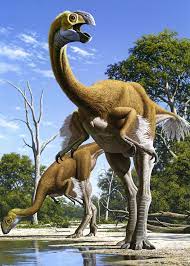
Gigantoraptor Dinosaur is an extinct genus of oviraptorosaurian theropod dinosaur that lived during the Late Cretaceous period. It was first discovered in 2005 from a single well-preserved skeleton in the Iren Dabasu Formation of Inner Mongolia. The skeleton was estimated to have come from an animal that was roughly 8 meters in length and 1.8 meters in height, which makes it one of the larger known oviraptorosaurian Theropods. Gigantoraptor belonged to a group of dinosaurs known as the oviraptorosaurs, which characterized by their small heads, beaks, and often long tails.
Oviraptorosaurs have been found in both North and South America, as well as in Asia and parts of Africa. They were among the earliest dinosaurs to have evolved bird-like features such as feathers. Gigantoraptor features several unique characteristics which make it a standout among other oviraptorosaurs. Most notably, its size would have been unrivaled among its contemporaries. It was only slightly smaller than its relative, the giant Deinocheirus, and even then, only in relative length; it was much taller. In addition, it had the highest number of foot claws of any known dinosaur, five on each foot, and its skull was unusually robust along its nasal region, providing extra protection to its eyes.
Gigantoraptor Facts :
| Name: | Gigantoraptor Dinosaurs |
| Size: | 8 meters |
| Main Facts: | Gigantoraptor was relatively lightly built with long, narrow limbs. This light yet powerful build allowed it to move quickly over short distances. It is possible that it ran from predators, such as other theropod predators like the huge Tyrannosaurus rex that lived at the same time. |
Another distinguishing feature of Gigantoraptor was its teeth - or lack thereof. Whereas many oviraptor species had teeth, Gigantoraptor had a beak-shaped snout and did not possess any teeth. It is assumed that this beak helped the dinosaur search for food in its environment. It is likely that the teeth in its ancestors' mouths were slowly replaced by the beak structure as Gigantoraptor evolved to fill its large size requirements, and that the beak was used to both shuck and bed off food sources.Despite being one of the largest oviraptorosaurs, Gigantoraptor was relatively lightly built with long, narrow limbs. This light yet powerful build allowed it to move quickly over short distances. It is possible that it ran from predators, such as other theropod predators like the huge Tyrannosaurus rex that lived at the same time.
It is not known what Gigantoraptor ate, but its large size points to a diet rich in plant-based food sources, such as nuts, fruits, and seeds. It is also thought that the dinosaur might have supplemented its diet with small animals. Due to the scarcity of Gigantoraptor fossils and the lack of data related to the species, it is difficult to make any definitive conclusions about its behavior or evolutionary history. Even so, the discovery of the Gigantoraptor skeleton has shed light on the evolution of the oviraptorosauria, and offered new insights into the diversity of ecosystems during the Late Cretaceous period.